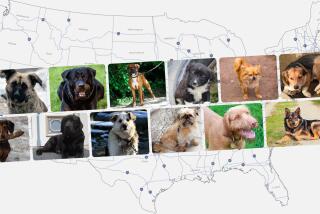Rumors have been flying since an adventurous wolf went missing in California

- Share via
California’s most adventurous wolf has not been heard from since biologists lost track of the “pings” emitted by OR-93’s radio collar on April 5 in San Luis Obispo County, about three hours’ drive north of Los Angeles.
Deepening the mystery, officials have not picked up a “mortality signal” from the young male’s collar, indicating that OR-93 had not moved for at least eight hours.
Where could he have gone?
In search of an answer, state biologists in Oregon and California on Friday said they are collaborating on a plan to fly over his epic path in a plane equipped to detect the faintest signals emitted by its GPS and radio transmitter.
“OR-93 hasn’t pinged since April 5 — and that’s been awful tough on us,” said Jordan Traverso, a spokeswoman for the California Department of Fish and Wildlife. “We’re trying to keep hope alive.”
“It’s not beyond the realm of possibility that OR-93 found some other wolves down there,” she said, “and is running with a Central Coast pack that no one knew existed.
“Or it could be that the radio collar is broken or malfunctioning due to dead batteries,” she said. “Then, too, this [wolf] may have been killed.”
There’s no shortage of theories among wolf advocates and wolf haters alike who have been keeping their eyes peeled for one unusually large long-legged canine predator — and they’re getting wilder by the hour.
Recent claims of sightings reported to state authorities and wildlife organizations include photos of “wolfish” looking paw prints in the wet sand at San Luis Obispo County’s Oceano Dunes State Vehicular Recreation Area, suggesting that OR-93 is still alive and enjoying the surf.
Other blurry photos of a grayish dog-like image in the distance suggest that the resilient, mobile and efficient hunter may be following his nose to his next meal, raising concerns among ranchers who regard wolves as four-legged killing machines.
OR-93’s official story began in June, when biologists fitted him with a GPS tracking collar near where he was born, south of Mt. Hood in western Oregon.
He left the pack and headed south, traveling swiftly and leaving a scented trail past Northern California lava beds, over snowy passes in the Sierra Nevada, along the outskirts of Yosemite National Park, into an agricultural area near Fresno. From there, he headed west toward the Central Coast, successfully crossing the 99, 5 and 101 freeways — three of the most perilous roads in the nation.
The GPS collar gave Oregon Department of Fish and Wildlife biologists a few downloads of data about its location each day that were shared with California wildlife authorities.
In California, wildlife authorities have been reluctant to reveal details about the 2-year-old wolf’s precise locations out of fear that it might make it easier for hunters to track him down and kill him.
The California Cattlemen’s Assn., which had been keeping track of the wolf’s progress in weekly bulletins, has decided not to announce that OR-93’s radio collar has gone silent.
“That fact doesn’t give us much new information that is beneficial to our members,” said Kirk Wilbur, the association’s vice president of government affairs. “For all we know that wolf is still running around in the place where the collar quit sending signals.”
“That’s too bad,” he added, “because it would be great to be able to alert folks in, say, Santa Barbara County that a gray wolf moved into their neighborhood.”
The fewer than a dozen wolves currently living in Northern California include the Lassen pack, which consists of five wolves, a new pair spotted in Siskiyou County last year, OR-93 and OR-103, a male that crossed into Northern California on May 4.
Before they were vanquished by government-backed poison-and-trapping campaigns in the 19th and 20th centuries, millions of wolves thrived in nearly every region of North America. Today, only about 6,000 wolves are left in the Lower 48 and as many as 12,000 in Alaska, where they are legally hunted as big game.
Gray wolves were removed from the federal endangered species list a year ago after the U.S. Fish and Wildlife Service determined the overall population was “stable and healthy throughout its current range.”
Since then, Idaho and Montana have passed new laws to drastically reduce wolf populations in those states.
Beth Pratt, California regional executive director for the National Wildlife Federation, was hoping that OR-93 has survived his record-breaking journey across California.
Reintroducing top predators to ancestral lairs where they were exterminated could help restore California’s out-of-balance wildlands.
Pratt was only half-kidding when she mused, “I keep hoping that someone will grab a photo of OR-93 that is clear and definitive — not fuzzy like the ones offered up as evidence of the existence of the Loch Ness monster and yeti.
“The ultimate Hollywood ending of this mystery,” she added with a laugh, “would be for OR-93 to settle down with a surfer girl canine in Malibu and raise a pack of cute pups.”
Amaroq Weiss, a spokeswoman for the Center for Biological Diversity, had something similar in mind when she wrote lyrics to a song set to the tune of the Beach Boys’ “California Girls.”
She performed it, with accompaniment by the Bitter Brush Blues Band, at a bar outside Pray, Mont., while attending the annual Northern American Interagency Wolf Conference there in 2002.
“The Alaskan wolves got trouble; land your plane and shoot them dead,
And the Minnesota wolves have got it just as bad, there’s a bounty on their head!
In Canada the hunters run them down with snowmobiles,
And in Maine, Vermont, and the Adirondacks, it’s gonna take some legal appeals!
I wish they all could be California;
I wish they all could be California;
I know that there should be California wolves!”
More to Read
Sign up for Essential California
The most important California stories and recommendations in your inbox every morning.
You may occasionally receive promotional content from the Los Angeles Times.











